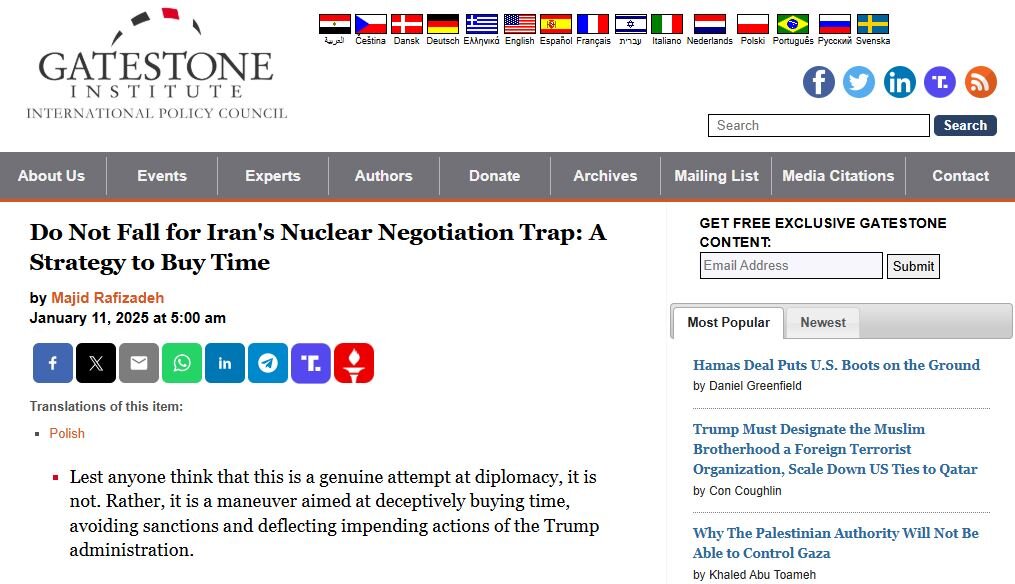Manufacturing threats: West’s constant fearmongering on Iran’s nuclear program

TEHRAN – For nearly two decades, Western analysts and policymakers have repeatedly claimed that Iran is on the verge of acquiring nuclear weapons.
Time and again, these predictions have been proven wrong. Yet, the same accusations continue to resurface, often as a pretext to justify economic sanctions and political pressure.
Majid Rafizadeh’s recent article, published by Gatestone Institute, warning about Iran’s nuclear ambitions is no different—it is built on misinformation, double standards, and a fundamental misunderstanding of Iran’s regional role.
One of the main claims in the article is that Iran is using diplomacy as a “deceptive maneuver” to buy time for developing nuclear weapons.
This argument ignores a crucial fact: Iran has always maintained that its nuclear program is for peaceful purposes, such as energy production and medical research. As a signatory of the Non-Proliferation Treaty (NPT), Iran has the legal right to develop nuclear technology, just like any other nation. Despite years of inspections by the International Atomic Energy Agency (IAEA), no concrete evidence has ever been found to prove that Iran is developing nuclear weapons.
Compare this to Israel, which has an undeclared nuclear arsenal and has never faced any form of scrutiny. While Iran is constantly accused of seeking nuclear weapons, Israel—despite not being a signatory to the NPT—continues to develop its nuclear capabilities and add to its nukes with full Western support. This double standard is at the heart of the issue. The problem is not Iran’s nuclear activities but rather the selective enforcement of non-proliferation policies by Western powers.
A history of false predictions
For more than 20 years, Western intelligence reports have claimed that Iran is “months away” from developing a nuclear bomb. These estimates have consistently turned out to be wrong. If Iran had truly been pursuing nuclear weapons, it would have built them long ago.
The reality is that these claims are politically motivated, designed to justify continued sanctions and military threats against Iran.
Moreover, Iran’s willingness to engage in negotiations—most notably through the 2015 Joint Comprehensive Plan of Action (JCPOA)—demonstrates that diplomacy, not deception, has been its primary approach. Iran complied with the JCPOA, allowing extensive inspections and limiting its nuclear activities. It was the United States that unilaterally withdrew from the deal in 2018, proving that the real problem was not Iran’s compliance but Washington’s unreliability.
West’s double standards and Iran’s role in regional security
The article paints Iran as a destabilizing force in West Asia, yet it conveniently ignores the role of the United States and its allies in creating regional chaos. The U.S. invaded Iraq in 2003 under false pretexts, leading to the rise of terrorist groups like Daesh (ISIS). The U.S. and NATO’s intervention in Libya turned the country into a failed state. Meanwhile, Washington continues to support repressive regimes in the region while accusing Iran of “exporting revolution.”
Iran, on the other hand, has been a key player in countering terrorism. Iran played a major role in fighting Daesh in Iraq and Syria, while the U.S. and its allies stood by as terrorist groups gained strength.
Iran’s regional allied groups that the West likes to refer to as “Iran-backed proxies” are in reality defensive alliances formed in response to external threats. Hezbollah, for example, was created as a response to Israel’s invasion of Lebanon in 1982. The Ansarullah in Yemen emerged as a reaction to a US-backed Saudi aggression. These groups are not tools of Iranian influence but rather regional forces defending their sovereignty. It is consistent with Iran's values to support these groups fighting for freedom and independence.
Who is the real threat?
The article claims that Iran’s nuclear program poses a global threat, yet it ignores the very real and ongoing military actions taken by the United States and Israel. The U.S. assassinated Iranian leaders, including General Qassem Soleimani in 2020, in a blatant act of war. Israeli airstrikes regularly target Syria, Lebanon, and Gaza, with no international consequences. Meanwhile, the U.S. military maintains bases across the Persian Gulf, constantly threatening Iranian security.
If any country is destabilizing West Asia, it is not Iran—it is the U.S. and its allies, who continue to impose their will on the region through military force and economic coercion.
‘Maximum Pressure’: a repeat of failed policies
Another flawed argument in the article is that Iran is “scrambling” to negotiate because of Donald Trump’s return to the White House. This assumption is not only wrong but ignores the failure of Trump’s “maximum pressure” campaign.
Trump imposed the harshest sanctions on Iran, withdrew from the nuclear deal, and increased military threats—yet Iran did not collapse. The Iranian economy adapted, and the government continued its policies despite external pressure. The idea that Iran fears Trump’s return is simply wishful thinking. The real question is whether the U.S. is ready to repeat a failed strategy that only increased tensions in the past.
Additionally, contrary to the claim that Iran is "scrambling" to negotiate, Iranian officials have consistently set conditions for any future diplomacy with Western nations. Iran is not pleading for talks; it is demanding clear guarantees and respect before even considering new agreements.
For nearly two decades, the world has heard the same warnings about Iran’s nuclear program—yet nothing has materialized. It is time to move beyond fear-mongering and misinformation and engage with Iran based on mutual respect and international law.
Iran is not the aggressor in West Asia—it is a nation that has repeatedly been threatened, sanctioned, and targeted by outside forces. If the West truly wants a peaceful future, it must abandon its failed policies and look for a win-win solution.
Leave a Comment